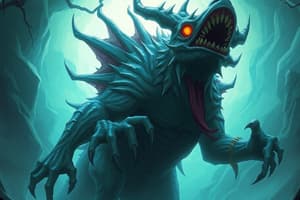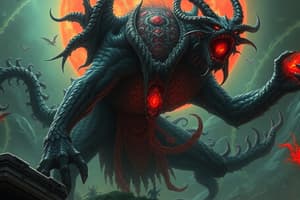Podcast
Questions and Answers
How does Philippine folklore contribute to the preservation of cultural heritage?
How does Philippine folklore contribute to the preservation of cultural heritage?
- By focusing solely on entertainment, thereby keeping the audience engaged without any educational content.
- By strictly standardizing beliefs across all regions, eliminating diverse interpretations.
- By creating giant figures that physically reshape the landscape.
- By reinforcing cultural identity and passing down traditional knowledge, practices, and values. (correct)
What factors contribute to the existence of regional variations within Philippine folklore?
What factors contribute to the existence of regional variations within Philippine folklore?
- Historical and cultural backgrounds, storytelling traditions, and rituals specific to each island and ethnic group. (correct)
- Philippine folklore doesn't have regional variations.
- A central authority strictly regulates the content and dissemination of stories, ensuring uniformity.
- The stories are intentionally altered to confuse outsiders and protect sacred knowledge.
What role does Philippine folklore play in community dynamics beyond mere entertainment?
What role does Philippine folklore play in community dynamics beyond mere entertainment?
- It distracts people from real societal problems.
- It enhances communal bonds, strengthens solidarity, and subtly addresses social issues and values. (correct)
- It primarily serves as a means of isolating communities, preserving unique rituals and beliefs.
- It strictly enforces social hierarchies, preventing social mobility and maintaining order.
How can studying Philippine folklore provide insights into the past?
How can studying Philippine folklore provide insights into the past?
Which of the following is NOT a significant function of folklore in Philippine society?
Which of the following is NOT a significant function of folklore in Philippine society?
Which characteristic most distinguishes myths from legends in Philippine folklore?
Which characteristic most distinguishes myths from legends in Philippine folklore?
How do proverbs function differently from folktales in transmitting cultural values?
How do proverbs function differently from folktales in transmitting cultural values?
In what way does the concept of 'Anito' reflect the relationship between Filipinos and their natural environment?
In what way does the concept of 'Anito' reflect the relationship between Filipinos and their natural environment?
Which of the following best illustrates the interplay between human relations and the supernatural in Philippine folklore?
Which of the following best illustrates the interplay between human relations and the supernatural in Philippine folklore?
How does the prevalence of the 'Aswang' figure in Philippine folklore reflect cultural anxieties?
How does the prevalence of the 'Aswang' figure in Philippine folklore reflect cultural anxieties?
If a community practices a ritual to ensure a bountiful harvest, which aspect of Philippine folklore does this embody?
If a community practices a ritual to ensure a bountiful harvest, which aspect of Philippine folklore does this embody?
What role do 'Diwatas' typically play in Philippine folklore, and how do they interact with humans?
What role do 'Diwatas' typically play in Philippine folklore, and how do they interact with humans?
A 'Mambabatok' uses supernatural powers to protect their village; how does this role contribute to the themes found in Philippine folklore?
A 'Mambabatok' uses supernatural powers to protect their village; how does this role contribute to the themes found in Philippine folklore?
Flashcards
Philippine Folklore
Philippine Folklore
A rich tapestry of myths, legends, folktales, proverbs, and narratives reflecting diverse cultures.
Myth
Myth
Stories explaining origins of the world and natural phenomena, often featuring supernatural beings.
Legend
Legend
Stories based on historical events or people, embellished with supernatural elements.
Folktale
Folktale
Signup and view all the flashcards
Proverb
Proverb
Signup and view all the flashcards
Anito
Anito
Signup and view all the flashcards
Diwata
Diwata
Signup and view all the flashcards
Aswang
Aswang
Signup and view all the flashcards
Regional Variations
Regional Variations
Signup and view all the flashcards
Cultural Identity
Cultural Identity
Signup and view all the flashcards
Community Bonding
Community Bonding
Signup and view all the flashcards
Passing Down Knowledge
Passing Down Knowledge
Signup and view all the flashcards
Study Notes
Introduction to Philippine Folklore
- Philippine folklore encompasses a rich collection of myths, legends, folktales, proverbs, and customary narratives.
- It reflects the diverse cultural heritage of the archipelago's numerous ethnic groups.
- Folklore plays a vital role in shaping cultural identity and transmitting knowledge across generations.
- These stories often embody symbolic representations of the environment, values, and beliefs of the people.
Types of Philippine Folklore
- Myth: Explanatory tales about the origin of the world, natural phenomena, and humankind, often featuring supernatural beings (deities and mythical creatures).
- Legend: Stories rooted in historical events or real people, embellished with supernatural elements.
- Folktale: Short narratives with moral lessons or embedded wisdom, sometimes comedic, tragic, or fantastical, and often featuring anthropomorphic characters.
- Proverbs: Concise statements of wisdom or beliefs, providing guidance on daily life.
- Riddle: A question or statement requiring a solution, often used in games and cultural activities.
- Customary Practices and Rituals: Traditional beliefs and practices relating to daily life and the environment, impacting healing, protection, agriculture, and festivals.
Themes in Philippine Folklore
- Nature and Environment: A deep connection to nature, reflected in stories about spirits, animals, and landscapes.
- Human Relations: Interactions between humans, spirits, and the natural world. Themes include family, community, and social values.
- Moral Lessons: Underpinning principles like courage, honesty, respect, and humility are embedded within the narratives.
- Supernatural Beings: A rich array of deities, spirits, and mythical creatures with specific roles and powers, influencing human-supernatural interactions.
- The Struggle for Survival: Tales depicting challenges faced by the archipelago's inhabitants, including natural disasters and external conflicts.
Key Figures and Concepts
- Anito: Indigenous spirits connected to nature; can be benevolent or malevolent, influencing agriculture, healthcare, and everyday life.
- Diwatas: Sky or nature deities.
- Aswang: A common supernatural figure depicted as a shapeshifting creature with malevolent intentions.
- Mambabatok: Sorcerers or figures with supernatural abilities.
- Dupata: A mythical monster.
- Giant figures: Often linked to the creation or development of the physical landscape.
Regional Variations
- Philippine folklore demonstrates significant variations in stories, beliefs, and characters across different regions.
- These differences originate from the unique historical and cultural contexts of the various islands and ethnic groups.
- Variations exist in storytelling traditions and rituals across the Philippines.
Importance of Folklore
- Cultural Identity: Philippine folklore maintains and strengthens cultural identity.
- Community Bonding: Sharing stories enhances community bonds and solidarity.
- Passing Down Knowledge: Stories preserve traditional knowledge and values (healthcare, agriculture, social customs) across generations.
- Entertainment and Education: Folklore provides entertainment and valuable life lessons.
- Social Commentary: Stories often address social issues and values of their time.
- Historical Insights: Folklore sometimes provides insights into the past.
Studying That Suits You
Use AI to generate personalized quizzes and flashcards to suit your learning preferences.




